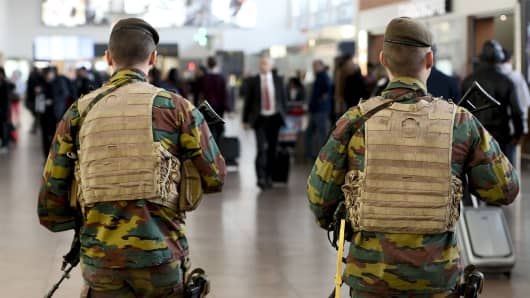At first review of the Brussels attacks on the airport and subway station that left at least 31 people dead and nearly 200 injured, all of the protective, preventive, and detective security measures seem to have failed. How could this be?
As investigators piece together the evidence, it will be necessary to analyze these events in terms of their proximate, intermediate, and remote causes and stages. Specifically, the protective measures that failed to detect and prevent the mass violence at the locations of explosions within the airport and train station (e.g., metal detectors, vigilance by security personnel) are different from the protective measures that failed to detect and prevent the planning of these terrorist actions from the locations of surveillance, analysis, and synthesis of information (e.g., regional and central intelligence offices). As it took an illicit global conspiracy to accomplish the fatal objectives, it will take global cooperation to anticipate, detect, confront, and prevent such co-conspirators.
One takeaway from these failures to protect people in public spaces is that whatever intelligence was applied in the field at the airport and train stations and whatever intelligence was applied in the offices of governmental and outsourced monitors of communications of information were collectively too broad. Accumulating too much information that can't be analyzed and used in a timely manner is ineffective. Whether they were negligent or worse (e.g., co-conspirators) will depend on the findings of the investigation. The agents that carried these weapons of mass destruction slipped through, creating the classic false negative (i.e., nothing to see here conclusions by security and other personnel at the local, regional, and central locations).
Those of us who have traveled, especially through airports, are keenly aware of the efforts made by security personnel to detect and prevent terrorist activity at the proximate stage (e.g., in the airport itself). Whether these efforts are in good faith, random, pursuant to tips, etc. cannot be determined by us as we patiently / impatiently trudge through the measures. We recognize and feel the classic false positive (i.e., much effort expended without discovery of means or intent to commit mass violence), as if making so many innocents wait their turn will deter real terrorists. Something is amiss.
Too much effort is wasted and wrongfully applied at the proximate stage. More effort and focus should be directed toward the analysis and synthesis of communications received from various intelligence offices at the intermediate/regional and remote/central stages. The explosions were the violent eruptions of plans that spanned networks, likely across different jurisdictions and cultures. The eruptions were not spontaneous or impromptu; they were planned well in advance and foreseeable as well through the exercise of due diligence by the security monitors, whether in the public or private sector.
The planners of these attacks did not originate these communications with one another in machine code. Inevitably and ultimately, they used natural language. These illicit plans were likely communicated across networks, wired and/or wireless. They were shared and discoverable.
While the temptation is great to hold the security personnel at the airport and train stations responsible for deficiency in performance (e.g., "If only they searched more individuals more intelligently…"), this would likely result in a failure to focus meaningfully on prevention of these eruptions well before they reach their destinations.
The pathways of these terrorists carrying these weapons originated well before the time and space of their detonations. That they could have been caught seems likely, given the level and sophistication of the technology and record keeping at the disposal of the state and its agents.
There seems to be too much of a focus on the display of security (e.g., searching innumerable innocents) instead of effective of security at a distance through the exercise of coordinated intelligence activity.
Commentary by David M. Shapiro, an assistant professor in the Dept. of Public Management at John Jay College of Criminal Justice, where he is also the deputy director of the Advanced Certificate in Forensic Accounting. Previously, he worked as senior executive, management consultant, corporate investigator, certified public accountant, assistant (county) prosecutor, and special agent – assistant legal advisor with the F.B.I. Follow him on Twitter @dshapiro32.
For more insight from CNBC contributors, follow
@CNBCopinion
on Twitter.





